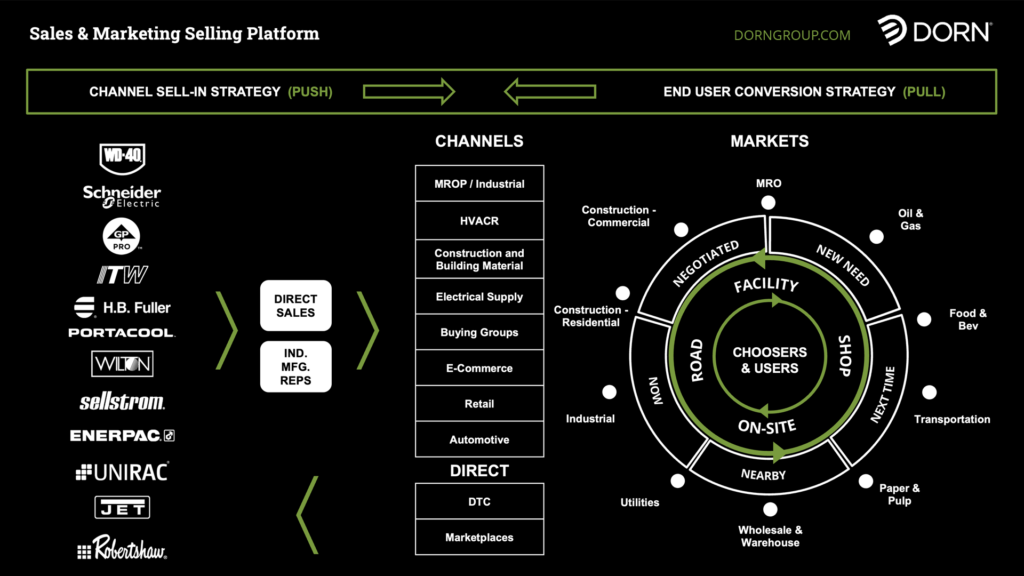Why Your Brand Stalls in Distribution (And How to Fix It)
I talk to manufacturers, IMRs, distributors, and end users almost every day, and one challenge keeps coming up:
“We’re in distribution, but sales aren’t moving like they should.”
Distributors carry thousands of SKUs. Even if your product has been in the system for years, that doesn’t mean it’s a priority today.
The hard truth? Most distributors aren’t in the business of creating demand—they focus on fulfilling it. And for the few that do, your product is likely competing with bigger priorities in their revenue and profit strategy.
That’s why the manufacturers winning in distribution take control of both push and pull. But they also go one step further: They don’t just sell a product—they sell a solution that delivers value to the end user.
What I Hear from Manufacturers
- “Our distributor used to push our product, now it feels like we’re just another line.”
- “We have strong market share, but we’re seeing erosion to competitors.”
- “We’re on distributor shelves, but we’re struggling to get sales teams engaged.”
What Distributors Say
- “We focus on the suppliers that invest in sales enablement.”
- “Preferred suppliers get better visibility and support.”
- “If the customer asks for it, we’ll sell it—but we’re not going to push every line equally.”
This is where a structured push-pull strategy and a value-added selling program separate market leaders from stagnating brands.

Winning the Distribution Game:
Push and Pull—Together
PUSH: Strengthen Distributor and IMR Engagement
- Ensure your product is prioritized in distributor sales programs.
- Use tiered distributor programs (MDF, co-op, SPIFFs, training incentives) to stay top-of-mind.
- Create high-impact sales enablement tools that make it easy for reps to sell your solution.
PULL: Create Demand at the End-User Level
- Sell a solution, not just a product—connect your offering to a real, high-value use case.
- Build a value-added selling program that makes it easy for distributors, IMRs, and sales teams to tell the story.
- Use direct sales engagement to ensure customers understand the long-term value of your solution.
By devoting resources to both push and pull at the same time, manufacturers create consistent momentum—securing distributor buy-in while ensuring end users are driving demand back through the channel.
Best Practice: Sell a Solution, Not Just a Product
One of the biggest mistakes manufacturers make is assuming that product features alone will drive demand. The reality? Buyers don’t buy features—they buy outcomes.
The Most Successful Brands in Distribution:
- Reposition their product as part of a larger workflow or problem-solving solution
- Develop a value-added selling program that gives sales reps and IMRs a clear narrative
- Use real-world customer success stories to reinforce why their solution is a must-have
One of our clients, for example, didn’t just sell a consumable. They built an end-to-end industrial maintenance solution that addressed real operational pain points. This wasn’t about selling a magic formula—it was about improving uptime, reducing failures, and making maintenance teams more efficient.
When manufacturers frame their product as a business solution instead of a commodity, they unlock new growth opportunities, both with end users and in distribution.
What Leading Manufacturers Do Differently
1. They Treat Distributors Like Growth Partners, Not Just Fulfillment Centers
- Quarterly business reviews to align priorities.
- Joint sales planning with distributor teams.
- Market development funds that drive real engagement.
2. They Keep IMRs Equipped and Engaged
- Give them a clear value story and simple selling playbooks.
- Make selling easier: shorter sales cycles, fewer objections, faster conversions.
- Align incentives—if they win, you win.
3. They Own the End-User Relationship
- Drive pull-through demand so distributors have a reason to prioritize your brand.
- Leverage data to spot trends and shifts before sales drop.
- Constantly refine positioning to keep their product top-tier in the category.
If Your Brand Is Losing Share in Distribution, Here’s What to Do.
You might be thinking, ‘Should I just call DORN?’ I won’t stop you—but here’s something to consider first. If you’re seeing slower growth, distributor disengagement, or competitors gaining ground, it’s time to rethink your push-pull strategy and your value-added selling approach.

